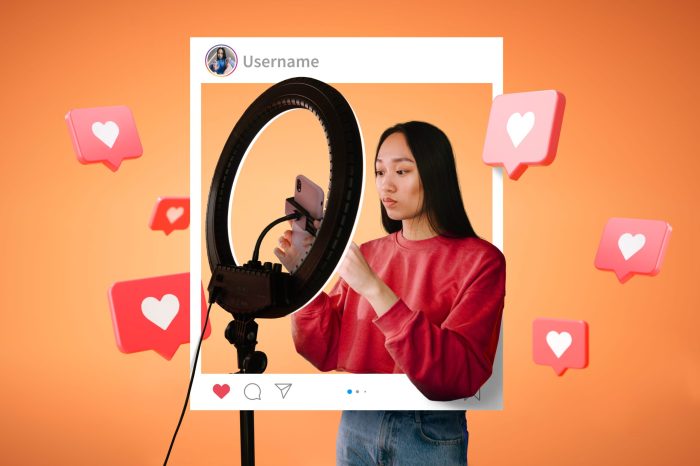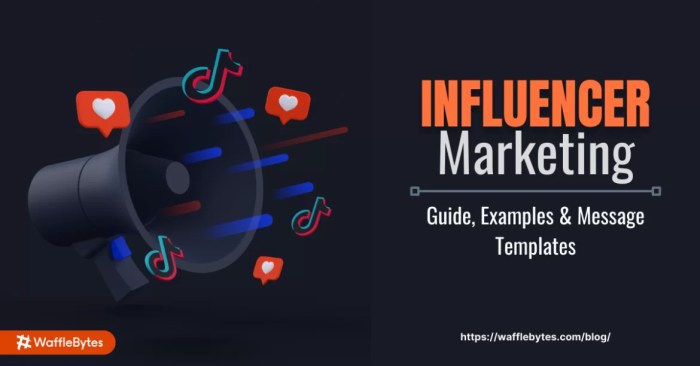Influencer Marketing Guide dives into the world of leveraging social media influencers to elevate your brand presence. Get ready to learn the secrets of successful influencer campaigns and how to choose the right influencer for your brand.
Overview of Influencer Marketing
Influencer marketing is all the rage these days, especially in the digital world where everyone is glued to their screens 24/7. It’s basically a strategy where brands collaborate with individuals who have a loyal following (aka influencers) to promote their products or services. And let me tell you, it’s a game-changer in today’s marketing landscape.Now, let me break it down for you – influencer marketing is like the cool kid at school who everyone wants to hang out with, while traditional marketing is like that teacher who just drones on and on in class.
With influencers, brands can reach their target audience in a more authentic and engaging way, making it feel like you’re getting recommendations from a friend rather than being bombarded with ads.
Successful Influencer Marketing Campaigns
Let’s take a look at some examples of influencer marketing done right in different industries:
- Beauty and Fashion: Remember when Kylie Jenner teamed up with Sugar Bear Hair to promote their vitamins on Instagram? That post went viral and sales skyrocketed!
- Travel and Lifestyle: The #ShotOniPhone campaign by Apple, featuring stunning photos taken by influencers around the world, created major buzz and showcased the iPhone’s camera capabilities.
- Food and Beverage: McDonald’s collaboration with various food bloggers and YouTubers to promote their limited-time menu items resulted in a feeding frenzy (pun intended) at their restaurants.
Types of Influencers

When it comes to influencer marketing, there are different categories of influencers based on their follower count and niche. Understanding these types can help you choose the right influencer for your marketing campaign.
Micro-Influencers
Micro-influencers have a smaller but highly engaged audience, usually ranging from 1,000 to 100,000 followers. They are known for their niche expertise and authenticity. Examples of micro-influencers include lifestyle bloggers, niche YouTubers, and Instagrammers focused on specific interests like fitness or travel.
Macro-Influencers
Macro-influencers have a larger following, typically between 100,000 to 1 million followers. They have a broader reach and can appeal to a wider audience. Examples of macro-influencers are popular beauty vloggers, fashion influencers, and gaming streamers with a substantial following.
Mega-Influencers
Mega-influencers are the celebrities of the influencer world, with over 1 million followers or more. They have a massive reach and influence across various platforms. Examples of mega-influencers include Hollywood actors, top musicians, and sports personalities. Understanding the differences between these types of influencers is crucial in selecting the right one for your marketing campaign. Consider factors like your target audience, brand image, budget, and campaign goals when choosing the influencer who aligns best with your objectives.
Finding the Right Influencers
Finding the right influencers for your brand is crucial for the success of your influencer marketing campaign. It requires careful planning, research, and alignment of values to ensure that the influencer resonates with your target audience.
Identifying and Researching Potential Influencers
When looking for potential influencers, consider factors such as their relevance to your industry, engagement with their audience, and authenticity. Research their content, audience demographics, and engagement rates to determine if they are a good fit for your brand.
- Utilize social media platforms like Instagram, TikTok, and YouTube to search for influencers in your niche.
- Look for influencers who already use or promote products similar to yours, as they are more likely to be interested in collaborating with your brand.
- Engage with their content, interact with their followers, and see how they engage with their audience to gauge their authenticity and influence.
Aligning Values and Audience, Influencer Marketing Guide
It’s essential to align the values and audience of the influencer with your brand to ensure a successful partnership. Make sure the influencer’s values and content align with your brand’s mission and values to maintain authenticity and credibility.
- Choose influencers whose audience matches your target demographic to maximize the impact of your campaign.
- Ensure that the influencer’s content aligns with your brand’s messaging and values to create a seamless partnership.
- Collaborate with influencers who genuinely believe in your brand and can authentically promote your products or services to their audience.
Using Influencer Marketing Platforms
Influencer marketing platforms can streamline the process of finding and connecting with influencers for your brand. These platforms provide valuable insights, data, and tools to help you identify the right influencers for your campaign.
- Explore influencer marketing platforms like Influencity, AspireIQ, and Upfluence to discover influencers in your niche.
- Use advanced search filters to narrow down influencers based on criteria such as audience demographics, engagement rates, and past collaborations.
- Reach out to influencers directly through these platforms to initiate partnerships and collaborations seamlessly.
Collaborating with Influencers: Influencer Marketing Guide
Collaborating with influencers is a key aspect of influencer marketing that can greatly impact the success of your campaign. It involves reaching out to influencers, negotiating partnerships, and establishing authentic relationships to promote your brand or product effectively.
Reaching out and Negotiating Partnerships
When reaching out to influencers, it’s essential to personalize your messages and clearly communicate your goals and expectations. Be respectful of their time and value their creativity and expertise. Negotiate partnerships by discussing compensation, deliverables, and timelines to ensure a mutually beneficial collaboration.
Creating Authentic and Long-Term Relationships
Building authentic and long-term relationships with influencers is crucial for the success of your campaigns. By investing in these relationships, you can establish trust, credibility, and loyalty, which can lead to more impactful collaborations in the future. Remember to engage with influencers regularly and show appreciation for their work.
Setting Clear Expectations and Goals
It’s important to set clear expectations and goals for influencer collaborations to ensure alignment and success. Define key performance indicators (KPIs), Artikel deliverables, and establish deadlines to keep everyone on the same page. Communicate openly and transparently to avoid any misunderstandings and achieve the desired results.
Measuring Influencer Marketing Success

In the world of influencer marketing, it’s crucial to track and measure the success of your campaigns to ensure you’re getting the most out of your partnerships. Key performance indicators (KPIs) play a vital role in evaluating the effectiveness of influencer campaigns, helping you understand what is working and what needs improvement.
Key Performance Indicators (KPIs)
- Reach: Measure the number of people who have seen the content posted by influencers. This gives you an idea of the campaign’s potential exposure.
- Engagement: Track likes, comments, shares, and other interactions to gauge how well the audience is engaging with the content.
- Conversion Rate: Monitor the number of conversions generated from the influencer campaign, such as sales, sign-ups, or downloads.
- Brand Sentiment: Evaluate the overall perception of your brand among consumers after the influencer collaboration.
Tracking ROI and Engagement Metrics
- ROI Calculation: Calculate the return on investment by comparing the overall costs of the campaign with the revenue or value generated.
- Engagement Metrics: Analyze metrics like click-through rates, website traffic, and time spent on the site to measure the level of engagement driven by influencers.
- Tracking Codes: Use unique tracking codes or affiliate links to attribute specific actions or purchases to influencer-driven traffic.
Tools and Platforms for Monitoring and Analysis
- Google Analytics: Utilize Google Analytics to track website traffic, conversions, and user behavior resulting from influencer campaigns.
- Social Media Insights: Platforms like Instagram and Facebook provide insights on post performance, audience demographics, and engagement metrics.
- Influencer Marketing Platforms: Tools like AspireIQ, Traackr, and Upfluence offer features for influencer discovery, campaign management, and performance tracking.






